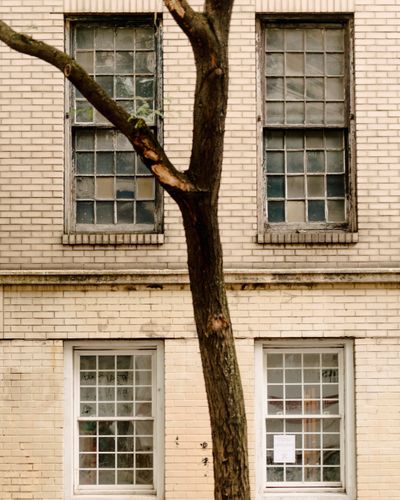Last-known ‘Colored’ school in Manhattan becomes a landmark

NEW YORK – For years, New York City Department of Sanitation workers ate their lunch in a three-story yellow brick building on West 17th Street in Chelsea without knowing about its history: It was once a “colored” school that served Black Americans during racial segregation in the city’s public schools.
On Tuesday, the city’s Landmarks Preservation Commission voted to designate the building, which had been known as Colored School No. 4, a protected landmark, and city officials announced that they would provide $6 million in funding to rehabilitate it.
“We stand on the shoulders of the young men and women that attended this school, and while they may be gone, I am honored to ensure they will never be forgotten,” Mayor Eric Adams said in a statement.
The schoolhouse was built around 1849 and became one of the city’s “colored schools” in 1860. There were eight public primary schools in Manhattan at the time that served 2,377 Black students. The school also housed an evening school for Black adults.
It was renamed Grammar School No. 81 in 1884, when the city’s Board of Education stopped using the term “colored” in the names of public schools, but it continued to serve Black children exclusively until the public school system closed segregated schools 10 years later.
The landmark designation comes as cities and states are grappling with how to address unsavory parts of American history, particularly Black history, as modern-day inequities persist in education and elsewhere.
While cities like New York appear to be moving toward speaking openly about the past, other places are moving in the opposite direction, fighting against the surfacing of such history by limiting how slavery and race are taught in American classrooms. Florida’s education department, for example, this month rejected dozens of social studies textbooks in an effort to remove material on contested topics surrounding race and social justice.
Sarah Carroll, the chair of the Landmarks Preservation Commission, said in a statement that the former Colored School No. 4 represented “a difficult, and often overlooked, period in our city’s history.” The decision to landmark it, she said, demonstrated “the importance of preserving the sites that tell the complete, sometimes challenging, story of our city.”
After the school closed in 1894, the building remained the property of New York City. It has been used for a variety of purposes since then, including as a clubhouse for Civil War veterans of the 73rd Regiment. From 1936 through 2015, it was used as a satellite office and locker facility for the Sanitation Department.
City officials estimate that the building, which has water damage, will be fully rehabilitated in 2027. It is unclear how it will be used after that, but officials said they would work with city agencies and local stakeholders to decide.
The landmark designation and funding for the building’s rehabilitation comes years after Eric K. Washington, a historian, in 2018 began urging the city to move to protect it. More than 2,800 people signed a petition in favor.
Washington said he first learned about the school while researching James H. Williams, the chief porter of Grand Central Terminal’s Red Caps, a group of Black men who worked at the railroad station.
Williams attended the former Colored School No. 4 and would have been one of its last students before it closed, Washington said.
“I feel delightfully exhausted,” Washington said in an interview Tuesday. He said he had filed two requests with the landmarks commission to evaluate the site since 2018 and had heard very little since. “My fingers are sore from being crossed all of this time.”
Washington said he was glad that the city was moving to protect the building at a time when others were making “really concerted, mean efforts” to erase and ban the teaching of Black history, which he said was an essential part of American history.
“I think that the fact that this school and what it represents is being landmarked in this major city will serve as an example to locales across the country, so I’m thrilled in that regard,” Washington said.
While the Sanitation Department had expressed support for rehabilitating the school, a spokesperson said last year that officials did not have the funds to do so.
Jessica Tisch, the commissioner of the Sanitation Department, said in a statement that Adams had “made a critical investment in preserving an important piece of Black history in New York City.”
Tisch said that officials would do their part to make sure “future generations know both about the harm caused at this site and about the resilience of the New Yorkers who resisted it.”
A mob of working-class white people who were upset by the first federal draft, and the fact that wealthier people were being allowed to evade the service, attacked the schoolhouse during the draft riots of July 1863, according to The New-York Tribune. Teachers barricaded doors, and the rioters eventually gave up.
Sarah J.S. Tompkins Garnet, the school’s principal, was instrumental in fighting back against that mob. She was one of the first Black female principals in the New York City public school system.
The school had several notable graduates, including Susan Elizabeth Frazier, who became the first Black teacher working in an integrated public school, and Walter F. Craig, a classical violinist.
“At a time when states are trying to erase Black history, we’re celebrating it,” council member Erik Bottcher, who represents a Manhattan district that includes Chelsea, said in a statement. Saving the building, he added, has been one of the neighborhood’s “top priorities.”
Another former “colored” school, No. 3 in Brooklyn, was designated a landmark in the late 1990s.
This article originally appeared in The New York Times.